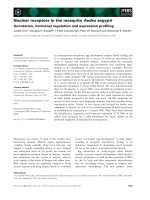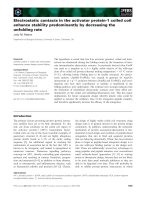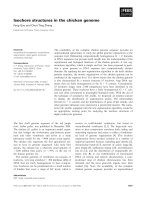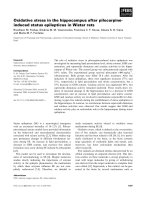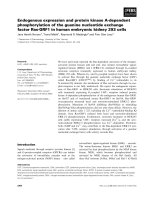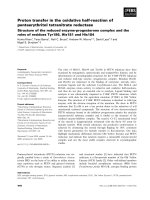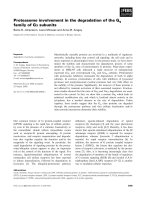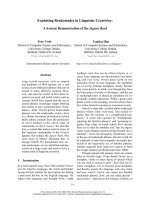Báo cáo khoa học: EcR expression in the prothoracicotropic hormoneproducing neurosecretory cells of the Bombyx mori brain ppt
Bạn đang xem bản rút gọn của tài liệu. Xem và tải ngay bản đầy đủ của tài liệu tại đây (779.71 KB, 8 trang )
EcR expression in the prothoracicotropic hormone-
producing neurosecretory cells of the Bombyx mori brain
An indication of the master cells of insect metamorphosis
Monwar Hossain
1
, Sakiko Shimizu
2
, Haruhiko Fujiwara
3
, Sho Sakurai
1,2
and Masafumi Iwami
1,2
1 Division of Life Sciences, Graduate School of Natural Science and Technology, Kanazawa University, Japan
2 Division of Biological Science, Graduate School of Natural Science and Technology, Kanazawa University, Japan
3 Department of Integrated Biosciences, Graduate School of Frontier Sciences, The University of Tokyo, Kashiwa, Japan
The insect brain is the center of developmental control.
In the brain of the silkworm Bombyx mori, two pairs
of lateral neurosecretory cells (LNCs) produce the
prothoracicotropic hormone (PTTH) [1,2]. The peptide
PTTH stimulates the prothoracic glands to synthesize
and release ecdysone [3]. The active form of ecdysone,
20-hydroxyecdysone (20E), controls many physiologi-
cal and developmental processes of insect molting and
metamorphosis [4]. Beside PTTH, the brain produces
many neurosecretory hormones that orchestrate devel-
opmental processes. It is also the target organ of 20E,
effecting dynamic morphological changes and rear-
rangement of the neural network during processes such
as the formation of the optic lobe and mushroom body
differentiation during metamorphosis [5,6]. Hence, the
analysis of 20E-induced gene expression in the brain is
of critical importance in understanding insect develop-
ment.
The 20E signal is mediated intrinsically through
binding with its heterodimeric nuclear receptor consist-
ing of the ecdysone receptor (EcR) and ultraspiracle
(USP) [7,8]. The 20E–receptor complex directly induces
several early genes and the products of these genes
activate late effector genes that control stage- and
tissue-specific developmental responses to 20E [9]. Two
EcR isoforms, EcR-A and EcR-B1, and two USP iso-
forms, usp-1 and usp-2, which have been identified in
Bombyx [10–13], are involved in specific responses to
Keywords
Bombyx mori; brain; ecdysone receptor;
metamorphosis; prothoracicotropic
hormone-producing neurosecretory cell
Correspondence
M. Iwami, Division of Life Sciences,
Graduate School of Natural Science and
Technology, Kanazawa University,
Kanazawa 920-1192, Japan
Fax: +81 76 2646251
Tel: +81 76 2646255
E-mail:
(Received 18 May 2006, revised 22 June
2006, accepted 26 June 2006)
doi:10.1111/j.1742-4658.2006.05398.x
The steroid hormone 20-hydroxyecdysone (20E) initiates insect molting and
metamorphosis through binding with a heterodimer of two nuclear recep-
tors, the ecdysone receptor (EcR) and ultraspiracle (USP). Expression of
the specific isoforms EcR-A and EcR-B1 governs steroid-induced responses
in the developing cells of the silkworm Bombyx mori. Here, analysis of
EcR-A and EcR-B1 expression during larval-pupal development showed
that both genes were up-regulated by 20E in the B. mori brain. Whole-
mount in situ hybridization and immunohistochemistry revealed that
EcR-A and EcR-B1 mRNAs and proteins were exclusively located in two
pairs of lateral neurosecretory cells in the larval brain known as the pro-
thoracicotropic hormone (PTTH)- producing cells (PTPCs). In the pupal
brain, EcR-A and EcR-B1 expression was detected in tritocerebral cells and
optic lobe cells in addition to PTPCs. As PTTH controls ecdysone secre-
tion by the prothoracic gland, these results indicate that 20E-responsive
PTPCs are the master cells of insect metamorphosis.
Abbreviations
20E, 20-hydroxyecdysone; EcR, ecdysone receptor; LNC, lateral neurosecretory cell; MEF2, myocyte enhancer factor 2; OLC, optic lobe cell;
NaCl ⁄ P
i
⁄ Tween, phosphate buffered saline containing Tween; PTPC, PTTH-producing neurosecretory cell; PTTH, prothoracicotropic
hormone; TCC, tritocerebral cell; USP, ultraspiracle.
FEBS Journal 273 (2006) 3861–3868 ª 2006 The Authors Journal compilation ª 2006 FEBS 3861
20E. EcR-A expression regulates neuronal maturation,
while EcR-B1 expression controls neuronal regression
both in Drosophila melanogaster [14,15] and Manduca
sexta [16]. Mutational analysis of EcR isoforms in
Drosophila identified several different lethal phases,
including developmental arrest late in embryogenesis,
failure of pupariation [17,18], and disruption of neur-
onal remodeling [18]. Although the effect of ecdysone
on neurons of the central nervous system has been
extensively studied in Drosophila and Manduca, little
information is available on the role of EcR expression
in the brain. In the present study, we examined EcR-A
and EcR-B1 expression in the Bombyx brain and
demonstrate stage- and cell-specific expression of EcR
isoforms, which is especially prominent in PTTH-
producing cells (PTPCs). These results provide an
insight into ecdysone receptor function in the brain
during larval-pupal-adult development.
Results
Expression of EcR-A and EcR-B1 in the Bombyx
brain
Day-2 fifth instar B. mori larvae were injected with
1 lg 20E (+20E) or Ringer’s solution ()20E), and
RNA was extracted from the brains 2 h after the injec-
tions. RT-PCR revealed that both EcR-A and EcR-B1
were weakly expressed in the absence of 20E, and
that 20E up-regulated the expression of both genes
(Fig. 1A). EcR-A was shown to be expressed at a
slightly higher level than EcR-B1 following induction
by 20E. No transcript was amplified after 25 cycles of
RT-PCR for both +20E and )20E samples. Expres-
sion of the control housekeeping gene RpL32 showed
no difference between +20E and )20E samples after
25 and 35 cycles of RT-PCR.
To examine spatial expression of EcR isoforms,
we carried out RT-PCR on RNA purified from the
anterior and the posterior sections of B. mori brains
(Fig. 1B). Intense EcR-A expression was observed
exclusively in the anterior part while no expression
was detected in the posterior part after 35 cycles of
RT-PCR (Fig. 1C). Strong EcR-B1 expression was also
detected in the anterior part of the brain and weaker
expression was detected in the posterior section, indi-
cating that both genes exhibit a spatial-specific pattern
of expression. RpL32 expression did not differ between
the two parts of the brain.
Cell-specific expression of EcR isoforms as
revealed by in situ hybridization
The spatial specificity of EcR-A and EcR-B1 expres-
sion was also determined by whole-mount in situ
hybridization of larval and pupal brains using EcR iso-
form-specific probes. EcR-A expression was detected
exclusively in two pairs of lateral neurosecretory cells
(LNCs) in day-2 (Fig. 2A) and day-7 (Fig. 2C) fifth
instar larval brains. The location of the EcR-A-positive
cells was assumed to be the same as that of PTTH-
producing cells (PTPCs), as shown in Fig. 2E. To con-
firm this, we performed in situ hybridization using a
mixture of EcR-A and PTTH probes. The hybridiza-
tion signal was again detected exclusively in the two
pairs of LNCs (Fig. 2G), indicating that EcR-A and
PTTH mRNAs were colocalized in PTPCs of the lar-
val brain. EcR-B1 expression was also detected exclu-
sively in the same LNCs in day-2 (Fig. 2B) and day-7
(Fig. 2D) fifth instar larval brains, while EcR-B1 and
PTTH expression was shown to colocalize in PTPCs
of the larval brain (Fig. 2H).
In the pupal brain, EcR-A expression was observed
in PTPCs (Fig. 2I,L) and in several tritocerebral cells
(TCCs) (Fig. 2K) and optic lobe cells (OLCs) (Fig. 2J).
EcR-B1 expression was similarly detected in PTPCs
(Fig. 2F), TCCs, and OLCs (Fig. 3E) but at a lower
level than EcR-A. In addition to the brain, faint
EcR-A expression was detected in the subesophagal
ganglion (Fig. 2K). Both EcR isoforms are therefore
A
B
C
Fig. 1. EcR-A and EcR-B1 are induced by 20E and are predominantly expressed in the anterior of day-2 fifth instar larval brains. (A) RT-PCR
analysis of EcR-A and EcR-B1 expression following injection of 20E (+20E) or Ringer’s solution ()20E). The number of PCR cycles is indica-
ted above the panel. The housekeeping gene RpL32 was used as a control. (B) Total RNA was extracted either from the anterior (A) or pos-
terior (P) part of the brains and analyzed by RT-PCR to assess the spatial distribution of gene expression. (C) RT-PCR analysis of EcR
expression using RNA from the anterior (A) and posterior (P) part of the brains. The number of PCR cycles is indicated above the panel.
EcR expression in PTTH cells of Bombyx mori brain M. Hossain et al.
3862 FEBS Journal 273 (2006) 3861–3868 ª 2006 The Authors Journal compilation ª 2006 FEBS
expressed exclusively in PTPCs at the larval stage and
in PTPCs, TCCs, and OLCs in the pupal stage of
B. mori development.
Immunohistochemical confirmation of EcR-A and
EcR-B1 cell-specific expression
To confirm the in situ hybridization results, we
performed double-labeled immunohistochemistry with
anti-EcR-A and anti-EcR-B1 sera, and anti-PTTH IgG
on the brains of day-2 and day-7 fifth instar larvae
and day-2 pupae. EcR-A and PTTH expression was
detected exclusively in two pairs of LNCs in day-2 fifth
instar larvae (Fig. 3A, left). The merged image shows
that EcR-A and PTTH expression colocalizes in
PTPCs. This colocalization was also observed in day-7
larval and day-2 pupal brains (Fig. 3B,C, left). The
same results were obtained for EcR-B1 (Fig. 3A–C,
right), confirming that both isoforms are colocalized in
PTPCs in the brain.
In the pupal brain, EcR-A and EcR-B1 expression
was observed in TCCs and weakly in OLCs in addi-
tion to PTPCs (Fig. 3D,E, also Fig. 2I,J). It is note-
worthy that EcR-B1 fluorescence was strongest just
beneath the cell membrane of TCCs (Fig. 3F) and
was weaker in the axons, while EcR-A fluorescence
was more diffuse throughout the cytoplasm (Fig. 3D,
also Fig. 3A), indicating that the distribution of the
two isoforms differed slightly. EcR-A and EcR-B1
expression was also detected in the subesophagal gan-
glion (Fig. 3D,E).
Discussion
In the present study, we have shown for the first
time that EcR-A and EcR-B1 are up-regulated by 20E
AB
DC
EF
HG
I
J
K
L
Fig. 2. Localization of EcR-A, EcR-B1 and
PTTH mRNAs by whole-mount in situ
hybridization. EcR-A and EcR-B1 mRNA was
detected in day-2 (A,B) and day-7 (C,D) fifth
instar larval brains and day-2 pupal brains
(F,I). For fifth instar day-2 specimens, brains
were dissected 2 h after 20E injection.
PTTH mRNA was detected in day-2 fifth
instar larval brains (E). (G) EcR-A and PTTH
as well as (H) EcR-B1and PTTH probes
were used simultaneously for hybridization
of day-2 larval brains. (A–E,G,H) show the
anterior portion of the larval brain. EcR-A
expression in the pupal brain (I) is magnified
in panels J–L, where OLCs (J, white
arrows), TCCs (K, white arrows) and PTPCs
(L, white arrows) are shown in green, blue,
and black boxes, respectively. The blue
arrows in K indicate faint signals in the sub-
esophagal ganglion. Scale bar ¼ 100 lm.
M. Hossain et al. EcR expression in PTTH cells of Bombyx mori brain
FEBS Journal 273 (2006) 3861–3868 ª 2006 The Authors Journal compilation ª 2006 FEBS 3863
exclusively in PTPCs in the B. mori larval brain. The
spatial specificity of EcR-A and EcR-B1 expression
was determined by in situ hybridization and confirmed
by immunohistochemistry using EcR isoform-specific
antibodies.
Expression of EcR-A and EcR-B1 in PTPCs has not
been reported previously. Recently, Vafopoulou et al.
[19] used immunohistochemistry to demonstrate EcR
expression in the medial neurosecretory cells of Rhodn-
ius prolixus. The postembryonic development of
Rhodnius and Bombyx is strikingly different. Unfed
Rhodnius larvae exist in an arrested developmental
state caused by an ecdysteroid deficiency [20], which is
immediately met by the consumption of a blood meal,
thus initiating development. No such phenomenon
exists in Bombyx larvae, and it is possible that the
difference in 20E-responsive cells between the two
insects reflects the different developmental systems.
Our study indicates that the expression level of EcR-
A is slightly higher than that of EcR-B1, as previously
observed during the neuronal maturation of Drosophila
and Manduca [16]. The developmental function of
EcR-A is distinct from those mediated by the EcR-B1
and EcR-B2 isoforms in Drosophila.AnEcR-A mutant
is arrested during early to mid-pupal development,
indicating that EcR-A is required for the formation of
the basic pupal body plan prior to the differentiation
of most adult structures [15]. By contrast, an EcR-B1
mutant is lethal at the first and second larval molts
[18] and fails to undergo pupariation [17].
PTPCs are the only cells to express EcR isoforms in
the Bombyx larval brain, and these cells also express
A
B
C
D
F
E
Fig. 3. Immunohistochemical localization of
EcR-A, EcR-B1, and PTTH. (A) Day-2 larval,
(B) day-7 larval and (C) day-2 pupal brains.
For fifth instar day-2 specimens, brains were
dissected 6 h after 20E injection. Anti-EcR-A,
anti-EcR-B1, and anti-PTTH were used as
primary antibodies. A FITC-conjugated anti-
rabbit secondary antibody was used to
detect EcR-A or EcR-B1, and a Texas-red
conjugated anti-mouse secondary antibody
was used to detect PTTH. The middle panel
(A–C) shows a merged (yellow) image of
the upper (green, EcR-A or EcR-B1) and
lower (red, PTTH) panels. (D) EcR-A and (E)
EcR-B1 expression in day-2 pupal brains.
White arrows in (D) and (E) indicate the
EcR-A- and EcR-B1-producing cells in the
tritocerebral region of the pupal brain,
respectively. Red arrows indicate the EcR-A-
or EcR-B1-producing cells in the subesopha-
gal ganglion, respectively. A magnified
image of the red box in (E) is shown in (F),
where EcR-B1 expression is indicated by
white arrows. Scale bar ¼ 100 lm.
EcR expression in PTTH cells of Bombyx mori brain M. Hossain et al.
3864 FEBS Journal 273 (2006) 3861–3868 ª 2006 The Authors Journal compilation ª 2006 FEBS
usp isoforms (MDM Hossain & M Iwami, unpub-
lished data). As the 20E signal is transduced via the
EcR–USP complex, it can be concluded that PTPCs
are the only cells to respond to 20E at the transcrip-
tional level, and these cells therefore play important
roles in 20E-dependent larval-pupal metamorphosis.
PTTH controls the hemolymph 20E level by stimula-
ting ecdysone synthesis and coordinating its release
from the prothoracic glands. EcR-A and EcR-B1
expression in the PTPCs suggests that 20E modulates
PTTH expression through a feedback loop. Beside its
prothoracicotropic effect, PTTH may act as a growth
factor as it shares a common ancestor with the verteb-
rate growth factor superfamily peptides such as nerve
growth factor, transforming growth factor, and plate-
let-derived growth factor [21]. It also enhances the syn-
thesis of several short-lived proteins that mediate a
variety of extracellular signals [22,23]. Despite the first
demonstration of PTTH almost three decades ago in
LNCs in Manduca [24] and later in Bombyx [1,2],
the molecular mechanisms of PTTH production and
release are still at an early level of understanding,
although these are of critical importance in insect
developmental control [25].
Since the work of Truman [26], it has been believed
that PTTH release is controlled by a circadian clock in
the brain [27–29]. The close association between clock
cells and PTPCs in the brain protocerebral region is
seen in the three divergent genera Rhodnius, Dro-
sophila, and Bombyx, suggesting that there are routes
of communication between these two cell populations
[30,31]. The association with clock cells and the
responsiveness of PTPCs for ecdysteroidogenesis sug-
gests that 20E influences PTTH release from PTPCs
through neurons that provide input to clock cells
[31,32]. The PTTH titer in Bombyx larval hemolymph
is, however, not exclusively controlled by photoperiod
and ⁄ or circadian clock mechanisms [27,28], as protho-
racicostatic hormones have been shown to influence
ecdysteroidogenesis and ecdysteroid release from the
PTTH-stimulated prothoracic gland [33,34]. At the
transcriptional level, Bombyx PTTH is regulated by
trans-regulatory factors such as myocyte enhancer fac-
tor 2 (MEF2) [32]. In the brain, MEF2 is expressed at
an elevated level in PTPCs and corazonin-like immu-
noreactive-LNCs. Over-expression of MEF2 increases
PTTH expression in Bombyx brain [32], while up-regu-
lation of MEF2 by 20E was reported in adult Dro-
sophila myoblasts [35]. An emerging hypothesis is that
MEF2 is regulated by 20E, which in turn modulates
PTTH expression.
In addition to PTPCs, EcR-A and EcR-B1 expres-
sion was detected in the tritocerebrum and the optic
lobe of day-2 pupae: a crucial stage for the morpholo-
gical and neurological reorganization of the brain. 20E
induces differentiation of the optic lobe and adult eye
in Manduca [5,36], while EcR is expressed during the
puparium stage in the optic lobe of Drosophila [16]. In
the present study, EcR expression in B. mori OLCs is
consistent with these findings. In the tritocerebrum, the
number and position of EcR-A-producing cells differed
from EcR-B1-producing cells. The intracellular local-
ization of EcR-A was also distinct from that of
EcR-B1: EcR-A was localized in the cytoplasm while
EcR-B1 was beneath or close to the cell membrane of
PTPCs and TCCs. The intracellular distribution of
EcR-B1 could indicate a nongenomic role for 20E in
these cells [37].
The present results clearly show that EcR isoform
expression in the brain is exclusive to the PTPCs until
pupation. This indicates that PTPCs are the master
cells during larval-pupal metamorphosis and that they
control ecdysteroidgenesis. At the pupal stage, the
number of cells expressing EcR isoforms increases to
include TCCs and OLCs. This unique expression pro-
file indicates the importance of EcR isoform expression
in TCCs and OLCs during larval-pupal metamorpho-
sis, although the roles of the individual isoforms in
these cells remain to be elucidated.
Experimental procedures
Animals and hormones
B. mori eggs of a racial hybrid, Kinshu · Showa were
obtained from Ueda Sanshu (Ueda, Japan), and larvae
were reared on an artificial diet (Silkmate II, Nihon Nou-
san Kogyo, Yokohama, Japan) under a 12 h light ⁄ 12 h
dark photoperiod at 25 ± 1 °C [38]. Ages were counted in
days, consisting of a photophase followed by a scotophase.
Fifth instar day-2 and day-7 larvae and day-2 pupae were
studied. 20E (Sigma, St. Louis, MO, USA) was dissolved in
ethanol and its concentration was determined spectrophoto-
metrically at 243 nm (e
EtOH
¼ 12 300). An aliquot of the
stock solution was evaporated and dissolved in insect Ring-
er’s solution (130 mm NaCl, 4.7 mm KCl, 1.9 mm CaCl
2
).
RNA isolation and semiquantitative RT-PCR
Total RNA was isolated from whole brains 2 h after the
injection of 20E (1 lg per larva) (+20E) or insect Ringer’s
solution ()20E) as a control. To determine the region of
expression in the brain, total RNA was isolated from the
anterior and posterior sections of brains. RNA was purified
by the acid guanidinium-thiocyanate ⁄ phenol ⁄ chloroform
method [39] with minor modifications [40].
M. Hossain et al. EcR expression in PTTH cells of Bombyx mori brain
FEBS Journal 273 (2006) 3861–3868 ª 2006 The Authors Journal compilation ª 2006 FEBS 3865
One microgram total RNA was reverse-transcribed in a
20 lL reaction using 100 U ReverTra Ace (Toyobo, Osaka,
Japan) and 5 pmol oligo(dT)
12)18
at 42 °C for 1 h accord-
ing to the manufacturer’s instructions. After reverse tran-
scription, the reaction was stopped by heating the solution
at 99 °C for 5 min, and the cDNA solution was diluted
five-fold with water. PCR primers were designed according
to the nucleotide sequences: EcR-A 5¢-TGGAGCTGAAA
CACGAGGTGGC-3¢ and 5¢-TCCCATTAGGGCTGTAC
GGACC-3¢, EcR-B1 5¢-ATAACGGTGGCTTCCCGCTG
CG-3¢ and 5¢-CGGTGTTGTGGGAGGCATTGGTA-3¢,
and RpL32 5¢-GAGGACGAAGAGATTTATCAGGCA-3¢
and 5¢-CGAAGAGACACCATGAGCGAT-3¢. PCR was
carried out in a 10 lL volume containing 10 mm Tris ⁄ HCl
(pH 8.8), 50 mm KCl, 1.5 mm MgCl
2
, 0.08% (v ⁄ v) Noni-
det P40, 0.2 mm each dNTPs, 0.5 mm each primer, 0.25 U
Taq DNA polymerase (Fermentas, Burlington, Ontario,
Canada), and 1 lL synthesized cDNA. The reaction was
subjected to 25 or 35 cycles of amplification in a thermo-
cycler (GeneAmp PCR System 9700, Applied Biosystems,
Foster City, CA, USA) using a thermal cycle (94 °C, 30 s;
60 °C, 30 s; 72 °C, 30 s). PCR products were separated on
a 1.5% (w ⁄ v) agarose gel and visualized by ethidium bro-
mide staining. There was no amplification without reverse
transcriptase even at 35 cycles of PCR (data not shown),
indicating the specificity of EcR-A and EcR-B1 mRNA
amplification.
In situ hybridization
Whole-mount in situ hybridization of brains was performed
as described previously [41]. After dissecting, brains were
washed with 10 mm phosphate buffered saline, pH 7.4
NaCl ⁄ P
i
⁄ 0.05% Tween20 and fixed in 85% (v ⁄ v) ethanol,
4% (w ⁄ v) formaldehyde, and 5% (v ⁄ v) acetic acid on ice
for 40 min. The brains were then incubated in a solution of
NaCl ⁄ P
i
containing 15% (w ⁄ v) sucrose at 4 °C for 15–20 h.
After washing with NaCl ⁄ Pi ⁄ 0.05% Tween20, the brains
were treated with proteinase K (0.05 mgÆmL
)1
in NaCl ⁄
Pi ⁄ 0.05% Tween20) at 37 °C for 40 min, and fixed again
with 3% (w ⁄ v) paraformaldehyde in NaCl ⁄ P
i
at room tem-
perature for 20 min. The brains were washed three times
with NaCl ⁄ P
i
⁄ 0.05% Tween20 and hybridized with 60 ng
EcR-A probe (5¢-TCCCATTAGGGCTGTACGGACC-3¢)
or EcR-B1 probe (5¢-CGGTGTTGTGGGAGGCATTG
GTA-3¢) and ⁄ or PTTH probe (5¢-GTACACAAACACGCC
ACGCTGACG-3¢)3¢-labeled with digoxigenin using a
Dig-labeled kit (Roche Diagnostics, Mannheim, Germany).
Hybridization was carried out at 37 °C for 20–48 h in a
100 lL hybridization solution [50% (v ⁄ v) formamide,
5· standard sodium citrate (NaCl ⁄ Cit; 0.15 m NaCl,
0.015 m sodium citrate), 5% (w ⁄ v) dextran sulphate]. After
sequential washing with 50% (v ⁄ v) formamide, 5 · NaCl ⁄
Cit and NaCl ⁄ P
i
⁄ 0.05% Tween20 at room temperature, the
brains were treated with 5% (v ⁄ v) sheep serum
(Rockland, Gilbertsville, PA, USA) at 4 °C for 15–20 h,
followed by a 2 h incubation with a 1 : 500 diluted alkaline
phosphatase conjugated anti-digoxigenin IgG (Roche
Diagnostics) at room temperature. Color development
was performed with 4-nitroblue-tetrazolium chloride
(336.4 lgÆmL
)1
) and 5-bromo-4-chloro-3-indolyl phos-
phate (175 lgÆmL
)1
) in the presence of 1 mm levamisole, a
potent inhibitor of endogenous alkali phosphatases. After
dehydration with ethanol, the brains were clarified with
methyl salicylate and observed with a microscope (BX-50F,
Olympus, Tokyo, Japan). Negative controls omitted the
labeled probes, and no signal was detected (data not
shown).
Anti-peptide serum for Bombyx EcR isoforms
An EcR-A specific peptide [H
2
N-GQVKAEPGVSHN
GHP(15–29)C-COOH] [13] (Accession no D87118) and an
EcR-B1 specific peptide [H
2
N-CPLPMPPTTPKSENES
MSSG(94–112)-COOH] [12] (Accession no D43943) were
synthesized, HPLC purified, and used to immunize rabbits
(Sawady Technology, Tokyo, Japan). Handling of rabbits
was performed according to regulation and guidelines of
the local authority. The anti-peptide serum titers for EcR-A
and EcR-B1, determined using an enzyme-linked immuno-
sorbent assay, were 4700 and 119 700, respectively.
Immunohistochemistry
Double-labeled fluorescent immunohistochemistry was used
to detect EcR-A, EcR-B1, and PTTH expression. Brains
were washed with NaCl ⁄ P
i
, fixed in Bouin’s solution over-
night, then washed with 70% (v ⁄ v) ethanol. The brains
were then soaked in 0.1% (w ⁄ v) sodium deoxycholate and
2% (v ⁄ v) Tween20 in NaCl ⁄ P
i
at 4 °C for 4 days to facili-
tate the penetration of antibodies through the brain sheath
[2]. The pretreated brains were incubated with rabbit anti-
Bombyx EcR-A serum (1 : 200) or anti-Bombyx EcR-B1
serum (1 : 300) and mouse anti-Bombyx PTTH monoclonal
IgG (1 : 100) [2] overnight. The brains were then incubated
simultaneously at 4 °C overnight with the secondary anti-
bodies, mouse anti-rabbit IgG conjugated with fluorescein
isothiocyanate (Cappel, Aurora, OH, USA) at a dilution of
1 : 400 for EcR-A and EcR-B1, and goat anti-mouse IgG
conjugated with Texas-Red (Cappel) at a dilution of 1 : 400
for PTTH. The brains were washed with NaCl ⁄
P
i
⁄ 0.05% Tween20 and clarified with methyl salicylate.
Fluorescence was detected using a fluorescence microscope
(BX-50F, Olympus) using NIBA filters for fluorescein isoth-
iocyanate and WIY filters for Texas-Red. Negative controls
replaced the primary antibodies with NaCl ⁄ P
i
⁄ 0.05%
Tween20 (data not shown). The absence of detectable flo-
rescence in these controls demonstrated the specificity of
the reaction. Images were processed with Adobe Photoshop
(Adobe Systems Inc, San Jose, CA, USA).
EcR expression in PTTH cells of Bombyx mori brain M. Hossain et al.
3866 FEBS Journal 273 (2006) 3861–3868 ª 2006 The Authors Journal compilation ª 2006 FEBS
Acknowledgements
We are grateful to Dr A. Mizoguchi for the gift of
the anti-PTTH antibody. This work was supported by
Grants-in-Aid for Scientific Research (15580039 and
18380040) from the Japan Society for the Promotion
of Science.
References
1 Kawakami A, Kataoka H, Oka T, Mizoguchi A, Kim-
ura-Kawakami M, Adachi T, Iwami M, Nagasawa H,
Suzuki A & Ishizaki H (1990) Molecular cloning of the
Bombyx mori prothoracicotropic hormone. Science 247,
1333–1335.
2 Mizoguchi A, Oka T, Kataoka H, Nagasawa H, Suzuki
A & Ishizaki H (1990) Immunohistochemical localiza-
tion of prothoracicotropic hormone-producing neurose-
cretory cells in the brain of Bombyx mori. Dev Growth
Differ 32, 591–598.
3 Gilbert LI, Rybczynski R & Warren JT (2002) Control
and biochemical nature of the ecdysteroidogenic path-
way. Annu Rev Entomol 47, 883–916.
4 Riddiford LM, Hiruma K, Zhou X & Nelson CA
(2003) Insights into the molecular basis of the hormonal
control of molting and metamorphosis from Manduca
sexta and Drosophila melanogaster. Insect Biochem Mol
Biol 33, 1327–1338.
5 Champlin DT & Truman JW (1998) Ecdysteroid con-
trol of cell proliferation during optic lobe neurogenesis
in the moth Manduca sexta . Development 125, 269–
277.
6 Kraft R, Levine RB & Restifo LL (1998) The steroid
hormone 20-hydroxyecdysone enhances neurite growth
of Drosophila mushroom body neurons isolated during
metamorphosis. J Neurosc 18, 8886–8899.
7 Thomas HE, Stunnenberg HG & Stewart AF (1993)
Heterodimerization of the Drosophila ecdysone receptor
with retinoid X receptor and ultraspiracle. Nature 362,
471–475.
8 Yao TP, Forman BM, Jlang Z, Cherbas L, Chen JD,
McKeown M, Cherbas P & Evans RM (1993) Func-
tional ecdysone receptor is the product of EcR and
Ultraspiracle genes. Nature 366, 476–479.
9 Thummel CS (1996) Files on steroids. Drosophila meta-
morphosis and the mechanisms of steroid hormone
action. Trends Genet 12, 306–310.
10 Tzertzinis G, Malecki A & Kafatos FC (1994) BmCF1,
a Bombyx mori RXR-type receptor related to the Droso-
phila ultraspiracle. J Mol Biol 238, 479–486.
11 Swevers L, Drevet JR, Junke MD & Iatrou K (1995)
The silkmoth homolog of the Drosophila ecdysone
receptor (B1 isoform): cloning and analysis of expres-
sion during follicular cell differentiation. Insect Biochem
Mol Biol 25, 857–866.
12 Kamimura M, Tomita S & Fujiwara H (1996) Molecu-
lar cloning of an ecdysone receptor (B1 isoform) homo-
logue from the silkworm, Bombyx mori, and its mRNA
expression during wing disc development. Comp Bio-
chem Physiol B 113, 341–347.
13 Kamimura M, Tomita S, Kiuchi M & Fujiwara H
(1997) Tissue-specific and stage-specific expression of
two silkworm ecdysone receptor isoforms. Ecdysteroid-
dependent transcription in cultured anterior silk glands.
Eur J Biochem 248, 786–793.
14 Brown HL, Cherbas L, Cherbas P & Truman JW (2005)
Use of time-lapse imaging and dominant negative recep-
tors to dissect the steroid receptor control of neuronal
remodeling in Drosophila. Development 133, 275–285.
15 Davis MB, Carney GE, Robertson AE & Bender M
(2005) Phenotypic analysis of EcR-A mutants suggests
that EcR isoforms have unique functions during Droso-
phila development. Dev Biol 282, 385–396.
16 Truman JW, Talbot WS, Fahrbach SE & Hogness DS
(1994) Ecdysone receptor expression in the CNS corre-
lates with stage-specific responses to ecdysteroids during
Drosophila and Manduca development. Development
120, 219–234.
17 Bender M, Imam FB, Talbot WS, Ganetzky B & Hog-
ness DS (1997) Drosophila ecdysone receptor mutations
reveal functional differences among receptor isoforms.
Cell 91, 777–788.
18 Schubiger M, Wade AA, Carney GE, Truman JW &
Bender M (1998) Drosophila EcR-B ecdysone receptor
isoforms are required for larval molting and for neuron
remodeling during metamorphosis. Development 125,
2053–2062.
19 Vafopoulou X, Steel CGH & Terry K (2005) Ecdyster-
oid receptor (EcR) shows marked differences in tem-
poral patterns between tissues during larval-adult
development in Rhodnius prolixus: correlations with hae-
molymph ecdysteroid titres. J Insect Physiol 51, 27–38.
20 Steel CGH, Bollenbacher WE, Smith SL & Gilbert LI
(1982) Haemolymph ecdysteroid titres during larval-
adult development in Rhodnius prolixus: correlations
with molting hormone action and brain neurosecretory
cell activity. J Insect Physiol 28, 519–525.
21 Noguti T, Adachi-Yamada T, Katagiri T, Kawakami A,
Iwami M, Ishibashi J, Kataoka H, Suzuki H, Go A &
Ishizaki H (1995) Insect prothoracicotropic hormone: a
new member of the vertebrate growth factor superfam-
ily. FEBS Lett 376, 251–256.
22 Keightley DA, Lou KJ & Smith WA (1990) Involve-
ment of translation and transcription in insect steroido-
genesis. Mol Cell Endocrinol 74, 229–237.
23 Rybczynski R, Bell SC & Gilbert LI (2001) Activation
of an extracellular signal-regulated kinase (ERK) by the
insect prothoracicotropic hormone. Mol Cell Endocrinol
184, 1–11.
M. Hossain et al. EcR expression in PTTH cells of Bombyx mori brain
FEBS Journal 273 (2006) 3861–3868 ª 2006 The Authors Journal compilation ª 2006 FEBS 3867
24 Agui N, Granger NA, Gilbert LI & Bollenbacher WE
(1979) Cellular localization of the insect prothoracico-
tropic hormone: In vitro assay of a single neurosecretory
cell. Proc Natl Acad Sci USA 76, 5694–5698.
25 Rybczynski R (2005) Prothoracicotropic hormone. In
Comprehensive Molecular Insect Science Vol. 3 (Gilbert
LI, Iatrou K & Gill SS, eds), pp. 61–123. Elsevier,
Oxford.
26 Truman JW (1972) Physiology of insect rhythms. 1. Cir-
cadian organization of the endocrine events underlying
the molting cycle of larval tobacco hornworm. J Exp
Biol 57, 805–820.
27 Mizoguchi A, Ohashi Y, Hosoda K, Ishibashi J &
Kataoka H (2001) Developmental profile of the changes
in the prothoracicotropic hormone titer in hemolymph
of the silkworm Bombyx mori: correlation with ecdyster-
oid secretion. Insect Biochem Mol Biol 31, 349–358.
28 Mizoguchi A, Dedos SG, Fugo H & Kataoka H (2002)
Basic pattern of fluctuation in hemolymph PTTH titers
during larval-pupal and pupal-adult development of the
silkworm, Bombyx mori. Gen Comp Endocrinol 127,
181–189.
29 Helfrich-Forster C (2003) The neuroarchitecture of the
circadian clock in the brain of Drosophila melanogaster.
Microsc Res Tech 62, 94–102.
30 Sehadova H, Markova EP, Sehnal F & Takeda M
(2004) Distribution of circadian clock-related proteins in
the cephalic nervous system of the silkworm, Bombyx
mori. J Biol Rhythms 19 , 466–482.
31 Vafopoulou X & Steel CGH (2005) Circadian organiza-
tion of the endocrine system. In Comprehensive Molecu-
lar Insect Scienc e Vol. 3, (Gilbert LI, Iatrou K & Gill
SS, eds), pp. 551–614. Elsevier, Oxford.
32 Shiomi K, Fujiwara Y, Atsumi T, Kajiura Z, Nakagaki
M, Tanaka Y, Mizoguchi A & Yaginuma T (2005)
Myocyte enhancer factor 2 (MEF2) is a key modulator of
the expression of the prothoracicotropic hormone gene in
the silkworm, Bombyx mori. FEBS J 272, 3853–3862.
33 Hua YJ, Tanaka Y, Nakamura K, Sakakibara M, Nag-
ata S & Kataoka H (1999) Identification of a prothora-
cicostatic peptide in the larval brain of the silkworm,
Bombyx mori. J Biol Chem 274, 31169–31173.
34 Yamanaka N, Hua YJ, Mizoguchi A, Watanabe K,
Niwa R, Tanaka Y & Kataoka H (2005) Identification
of a novel prothoracicostatic hormone and its receptor
in the silkworm Bombyx mori. J Biol Chem 280, 14684–
14690.
35 Lovato TL, Benjamin AR & Cripps RM (2005) Tran-
scription of Myocyte enhancer factor-2 in adult Droso-
phila myoblasts is induced by the steroid hormone
ecdysone. Dev Biol 288, 612–621.
36 Champlin DT & Truman JW (1998) Ecdysteroids gov-
ern two phases of eye development during metamorpho-
sis of the moth, Manduca sexta. Development 125, 2009–
2018.
37 Schlattner U, Vafopoulou X, Steel CG, Hormann RE &
Lezzi M (2006) Non-genomic ecdysone effects and the
invertebrate nuclear steroid hormone receptor EcR-new
role for an ‘old’ receptor? Mol Cell Endocrinol 247,
64–72.
38 Sakurai S (1984) Temporal organization of endocrine
events underlying larval-pupal metamorphosis in
the silkworm, Bombyx mori. J Insect Physiol 30,
657–664.
39 Chomczynski P & Sacchi N (1987) Single-step method
of RNA isolation by acid guanidinium thiocyanate-phe-
nol-chloroform extraction. Anal Biochem 162, 156–159.
40 Tsuzuki S, Iwami M & Sakurai S (2001) Ecdysteroid-
inducible genes in the programmed cell death during
insect metamorphosis. Insect Biochem Mol Biol 31,
321–331.
41 Iwami M, Tanaka A, Hano N & Sakurai S (1996)
Bombyxin gene expression in tissues other than brain
detected by reverse transcription-polymerase chain reac-
tion (RT-PCR) and in situ hybridization. Experientia
52, 882–887.
EcR expression in PTTH cells of Bombyx mori brain M. Hossain et al.
3868 FEBS Journal 273 (2006) 3861–3868 ª 2006 The Authors Journal compilation ª 2006 FEBS
